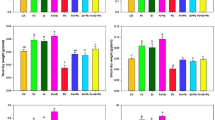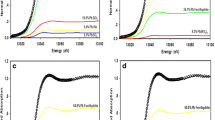Abstract
The current study investigated the effects of nano-silicon (Si) and common Si on lead (Pb) toxicity, uptake, translocation, and accumulation in the rice cultivars Yangdao 6 and Yu 44 grown in soil containing two different Pb levels (500 mg∙kg–1 and 1000 mg∙kg–1). The results showed that Si application alleviated the toxic effects of Pb on rice growth. Under soil Pb treatments of 500 and 1000 mg∙kg–1, the biomasses of plants supplied with common Si and nano-Si were 1.8%–5.2% and 3.3%–11.8% higher, respectively, than those of plants with no Si supply (control). Compared to the control, Pb concentrations in rice shoots supplied with common Si and nano-Si were reduced by 14.3%–31.4% and 27.6%–54.0%, respectively. Pb concentrations in rice grains treated with common Si and nano-Si decreased by 21.3%–40.9% and 38.6%–64.8%, respectively. Pb translocation factors (TFs) from roots to shoots decreased by 15.0%–29.3% and 25.6%–50.8%, respectively. The TFs from shoots to grains reduced by 8.3%–13.7% and 15.3%–21.1%, respectively, after Si application. The magnitudes of the effects observed on plants decreased in the following order: nano-Si treatment>common Si treatment and high-grain- Pb-accumulating cultivar (Yangdao 6)>low-grain-Pbaccumulating cultivar (Yu 44) and heavy Pb stress (1000 mg∙kg–1)>moderate Pb stress (500 mg∙kg–1)>no Pb treatment. The results of the study indicate that nano-Si is more efficient than common Si in ameliorating the toxic effects of Pb on rice growth, preventing Pb transfer from rice roots to aboveground parts, and blocking Pb accumulation in rice grains, especially in high-Pbaccumulating rice cultivars and in heavily Pb-polluted soils.
Similar content being viewed by others
References
Yadav S K. Heavy metals toxicity in plants: an overview on the role of glutathione and phytochelatins in heavy metal stress tolerance of plants. South African Journal of Botany, 2010, 76(2): 167–179
Duong T T T, Lee B K. Determining contamination level of heavy metals in road dust from busy traffic areas with different characteristics. Journal of Environmental Management, 2011, 92(3): 554–562
Yang Q W, Shu W S, Qiu J W, Wang H B, Lan C Y. Lead in paddy soils and rice plants and its potential health risk around Lechang lead/zinc mine, Guangdong, China. Environment International, 2004, 30(7): 883–889
Wei B, Yang L. A review of heavy metal contaminations in urban soils, urban road dusts and agricultural soils from China. Microchemical Journal, 2010, 94(2): 99–107
Silbergeld E K, Waalkes M, Rice J M. Lead as a carcinogen: experimental evidence and mechanisms of action. American Journal of Industrial Medicine, 2000, 38(3): 316–323
Zhuang P, McBride M B, Xia H, Li N, Li Z. Health risk from heavy metals via consumption of food crops in the vicinity of Dabaoshan mine, South China. Science of the Total Environment, 2009, 407(5): 1551–1561
Gong H J, Randall D P, Flowers T J. Silicon deposition in the root reduces sodium uptake in rice (Oryza sativa L.) seedlings by reducing bypass flow. Plant, Cell & Environment, 2006, 29(10): 1970–1979
Shetty R, Jensen B, Shetty N P, Hansen M, Hansen C W, Starkey K R, Jørgensen H J L. Silicon induced resistance against powdery mildew of roses caused by Podosphaera pannosa. Plant Pathology, 2012, 61(1): 120–131
Mateos-Naranjo E, Andrades-Moreno L, Davy A J. Silicon alleviates deleterious effects of high salinity on the halophytic grass Spartina densiflora. Plant Physiology and Biochemistry, 2013, 63: 115–121
Li P, Song A, Li Z J, Fan F L, Liang Y C. Silicon ameliorates manganese toxicity by regulating manganese transport and antioxidant reactions in rice (Oryza sativa L.). Plant and Soil, 2012, 354(1–2): 407–419
Song A, Li Z, Zhang J, Xue G, Fan F, Liang Y. Silicon-enhanced resistance to cadmium toxicity in Brassica chinensis L. is attributed to Si-suppressed cadmium uptake and transport and Si-enhanced antioxidant defense capacity. Journal of Hazardous Materials, 2009, 172(1): 74–83
Ali S, Farooq M A, Yasmeen T, Hussain S, Arif M S, Abbas F, Bharwana S A, Zhang G. The influence of silicon on barley growth, photosynthesis and ultra-structure under chromium stress. Ecotoxicology and Environmental Safety, 2013, 89: 66–72
Shi Q, Bao Z, Zhu Z, He Y, Qian Q, Yu J. Silicon-mediated alleviation of Mn toxicity in Cucumis sativus in relation to activities of superoxide dismutase and ascorbate peroxidase. Phytochemistry, 2005, 66(13): 1551–1559
Kaya C, Tuna A L, Sonmez O, Ince F, Higgs D. Mitigation effects of silicon on maize plants grown at high zinc. Journal of Plant Nutrition, 2009, 32(10): 1788–1798
Rizwan M, Meunier J D, Miche H, Keller C. Effect of silicon on reducing cadmium toxicity in durum wheat (Triticum turgidum L. cv. Claudio W.) grown in a soil with aged contamination. Journal of Hazardous Materials, 2012, 209–210: 326–334
Wu J W, Shi Y, Zhu Y X, Wang Y C, Gong H J. Mechanisms of enhanced heavy metal tolerance in plants by silicon: a review. Pedosphere, 2013, 23(6): 815–825
Liu J G, Li K Q, Xu J K, Zhang Z J, Ma T B, Lu X L, Yang J C, Zhu Q S. Lead toxicity, uptake and translocation in different rice cultivars. Plant Science, 2003, 165(4): 793–802
Wang S H, Luo Q S, Liu C P, Li F B, Shen Z G. Effects of leaf application of nanometer silicon to the accumulation of heavy metals in rice grains. Ecology & Environment, 2007, 16(5): 875–878 (in Chinese)
Doncheva S, Poschenrieder C, Stoyanova Z, Georgieva K, Velichkova M, Barceló J. Silicon amelioration of manganese toxicity in Mn-sensitive and Mn-tolerant maize varieties. Environmental and Experimental Botany, 2009, 65(2–3): 189–197
Katayama H, Banba N, Sugimura Y, Tatsumi M, Kusakari S, Oyama H, Nakahira A. Subcellular compartmentation of strontium and zinc in mulberry idioblasts in relation to phytoremediation potential. atEnvironmental and Experimental Botany, 2013, 85: 30–35
Liu J, Zhang H, Zhang Y, Chai T. Silicon attenuates cadmium toxicity in Solanum nigrum L. by reducing cadmium uptake and oxidative stress. Plant Physiology and Biochemistry, 2013, 68: 1–7
Khandekar S, Leisner S. Soluble silicon modulates expression of Arabidopsis thaliana genes involved in copper stress. Journal of Plant Physiology, 2011, 168(7): 699–705
Nwugo C C, Huerta A J. Silicon-induced cadmium resistance in rice (Oryza sativa). Journal of Plant Nutrition and Soil Science, 2008, 171(6): 841–848
Ma J F, Tamai K, Yamaji N, Mitani N, Konishi S, Katsuhara M, Ishiguro M, Murata Y, Yano M. A silicon transporter in rice. Nature, 2006, 440(7084): 688–691
Liu J G, Zhang W, Qu P, Wang M X. Cadmium tolerance and accumulation in fifteen wetland plant species from cadmiumpolluted water in constructed wetlands. Frontiers of Environmental Science & Engineering, doi: 10.1007/s11783-014-0746-x
Inal A, Pilbeam D J, Gunes A. Silicon increases tolerance to boron toxicity and reduces oxidative damage in barley. Journal of Plant Nutrition, 2009, 32(1): 112–128
Rogalla H, Rö mheld V. Role of leaf apoplast in silicon-mediated manganese tolerance of Cucumis sativus L. Plant, Cell & Environment, 2002, 25(4): 549–555
Vaculík M, Landberg T, Greger M, Luxová M, Stoláriková M, Lux A. Silicon modifies root anatomy, and uptake and subcellular distribution of cadmium in young maize plants. Annals of Botany, 2012, 110(2): 433–443
Ye J, Yan C, Liu J, Lu H, Liu T, Song Z. Effects of silicon on the distribution of cadmium compartmentation in root tips of Kandelia obovata (S., L.) Yong. Environmental Pollution, 2012, 162: 369–373
Author information
Authors and Affiliations
Corresponding author
Rights and permissions
About this article
Cite this article
Liu, J., Cai, H., Mei, C. et al. Effects of nano-silicon and common silicon on lead uptake and translocation in two rice cultivars. Front. Environ. Sci. Eng. 9, 905–911 (2015). https://doi.org/10.1007/s11783-015-0786-x
Received:
Accepted:
Published:
Issue Date:
DOI: https://doi.org/10.1007/s11783-015-0786-x




